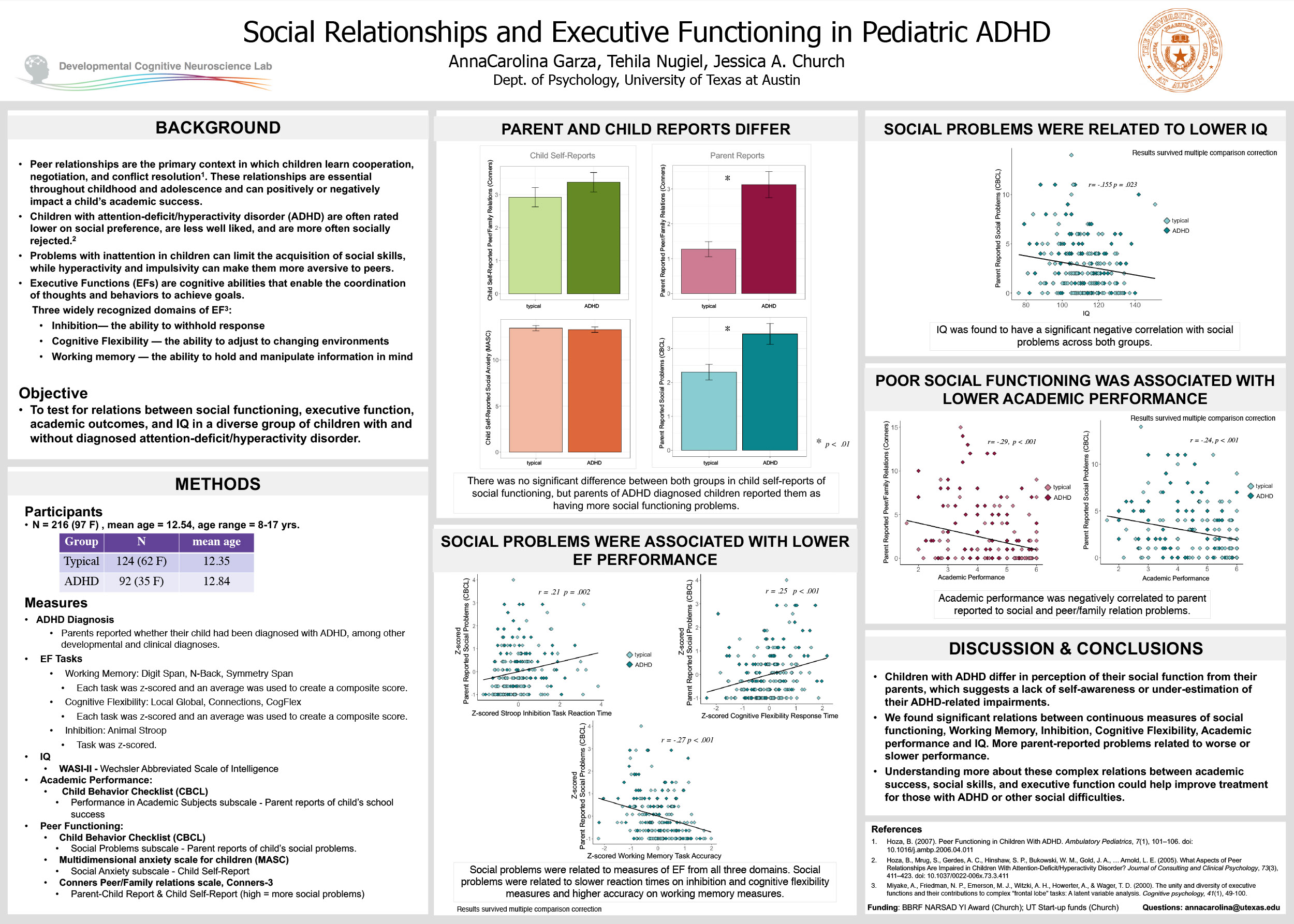AnnaCarolina Garza, Tehila Nugiel, Jessica A. Church
Peer relationships are essential throughout childhood and adolescence and can positively or negatively impact a child’s academic success. Our objective is to test for relations between peer functioning, executive function, IQ, and academic outcomes in children with and without diagnosed attention-deficit/hyperactivity disorder. The core symptoms of ADHD often result in children having more difficulty in peer social relationships. Data will be analyzed from 216 participants (119= Boys, 97= Girls) with a mean age of 12.54, 92 of whom were diagnosed with ADHD. To measure executive function, performance on three tasks related to core domains of executive function – cognitive flexibility, working memory, and inhibition – were used. Parent reports of school success were used to assess academic outcomes. For peer functioning measures, parent and child reports about their peer and family relations and social skills were obtained. We will correlate executive function scores and academic achievement measures with peer/family relations scores and social skill scores. Problems with inattention in children can limit the acquisition of social skills, while hyperactivity and impulsivity can make them more aversive to peers; understanding more about the complex relations between academic success, social skills, and executive function could help improve treatment for ADHD.

Comments
This is a well-designed study and poster! I’m hoping I can do this well of a job next year when I write my senior thesis. Anyway, I am curious to know: Assuming that there were children far below the mean age and higher above it, how did you adjust measures given that younger kids naturally are less inhibited and older children should be more skilled at inhibition? What is the importance of the finding that children who have ADHD and their parents differ in their perception of symptoms? What problems or even possibly protective factors might this provide? How do you see treatment being improved with your findings? Thanks in advance! – Kylie Northam
Hi Kylie, Thank you so much! That is a great point: these models aren’t accounting for age, and an important step in the future direction of this analysis is to test how much variance age accounts for in these relationships. Finding that children and parents differ in perception of their symptoms could mean that children with ADHD are less self-aware, possibly reflecting a source of problems in their social relationships. Or, this could mean that parents are inflating their children’s symptoms since they know their child is diagnosed with ADHD. No one likes to think of themselves as unpopular, but if parents are more accurate, this could be an indicator of some adjustments in perceptions and actions that a child could make to how they interact socially. This could mean that those parents who are more aware of problems are providing more social and emotional support to their children. While there are many treatment methods for other symptoms of ADHD, there are few treatments that target social problems directly. The implications of these conclusions can guide future research and development of a treatment that targets peer functioning directly. – AnnaCarolina Garza
I’m not familiar with the pediatric ADHD literature, so I was wondering about the EF tasks you administered. Was it difficult administering so many tests to children? And I’m familiar with a Stroop test, but what’s an animal Stroop? – Rob Reichle
Hi Rob, we’ve been administering these tests to children for a few years now, so with the help of many lab members, it wasn’t too difficult. In the animal Stroop task, we ask children to look at pictures where the head of the animal has been swapped with another animal and asked them to name the body of the animal. Children have to inhibit the response based on the face in order to correctly name the body of the animal. It doesn’t require reading like the traditional Stroop. – AnnaCarolina Garza
Wow, I am glad I asked about animal Stroop, because that is very different from what I’m used to with traditional Stroop! Thanks for the explanation. – Rob Reichle

